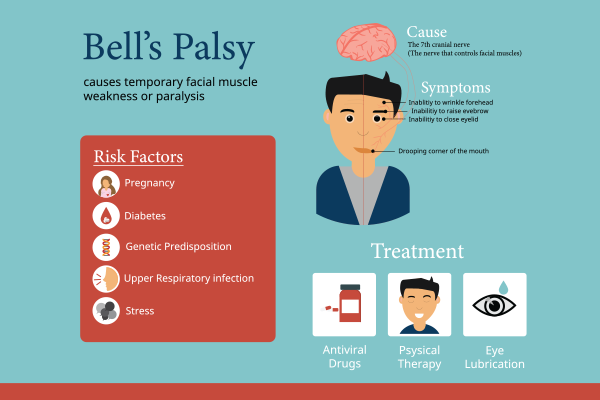
Imagine waking up one day and realizing that one side of your face feels numb or droopy. You try to smile, but only half of your face responds. This sudden and often alarming condition is known as Bell’s Palsy. It affects the facial nerves, causing temporary weakness or paralysis. While it can be frightening, the good news is that most people recover completely with proper treatment and care.

Synopsis
What is Bell’s Palsy?
Bell’s Palsy is a neurological disorder that results in temporary paralysis or weakness of the facial muscles. It occurs due to inflammation or compression of the facial nerve (cranial nerve VII), which controls facial movements. The condition can develop overnight and is often mistaken for a stroke, although it is not life-threatening.
Bell’s Palsy Causes
The exact cause of Bell’s Palsy is still unknown, but medical experts believe that viral infections play a significant role. Some common factors that may trigger Bell’s Palsy include:
-
Viral Infections: Reactivation of viruses like herpes simplex (which causes cold sores) and varicella-zoster (which causes chickenpox and shingles) is strongly linked to Bell’s Palsy.
-
Autoimmune Reactions: The immune system may mistakenly attack the facial nerve, causing inflammation and dysfunction.
-
Stress and Fatigue: High stress levels and lack of sleep can weaken the immune system, making the body more susceptible to viral infections.
-
Cold Weather Exposure: Some studies suggest that exposure to cold temperatures can increase the risk of developing Bell’s Palsy.
-
Diabetes: People with diabetes have a higher risk due to poor blood circulation and increased vulnerability to nerve damage.
-
Hypertension (High Blood Pressure): Restricted blood flow can contribute to nerve dysfunction.
-
Pregnancy: Hormonal changes and fluid retention during pregnancy may put extra pressure on the facial nerve, leading to Bell’s Palsy.
Bell’s Palsy Symptoms
The symptoms of Bell’s Palsy usually appear suddenly and peak within 48 hours. Here’s what to watch out for:
Primary Symptoms:
-
Sudden weakness or paralysis on one side of the face.
-
Difficulty closing the eye on the affected side.
-
Drooping of the mouth and eyelid.
-
Loss of taste sensation on the front two-thirds of the tongue.
-
Increased sensitivity to sound in one ear (Hyperacusis).
-
Dryness in the eye or excessive tearing.
-
Difficulty eating, drinking, or speaking clearly.
Additional Symptoms:
-
Headache or mild pain around the jaw and ear.
-
Twitching or spasms of facial muscles.
-
Drooling due to difficulty in controlling saliva.
-
Numbness or tingling in the affected area.
Bell’s Palsy Treatment
While most cases of Bell’s Palsy resolve within weeks to months, early treatment can speed up recovery and reduce complications. Below are some common treatment options:
Medical Treatments:
-
Corticosteroids: Anti-inflammatory drugs are commonly prescribed to reduce nerve swelling and improve recovery.
-
Antiviral Medications: If a viral infection is suspected, doctors may prescribe antiviral drugs.
-
Eye Protection: Since the eyelid may not close properly, using lubricating eye drops, artificial tears, or an eye patch at night can prevent dryness and irritation.
Physical Therapy and Home Remedies:
-
Facial Exercises: Gentle facial exercises and massage can improve muscle strength and prevent stiffness.
-
Warm Compress: Applying a warm towel to the affected area can enhance blood circulation and ease discomfort.
-
Acupuncture: Some studies suggest that acupuncture may help improve nerve function and speed up recovery.
-
Vitamin B12 and B6: These vitamins play a crucial role in nerve repair and may aid in faster recovery.
-
Stress Management: Practicing yoga, meditation, and deep breathing exercises can help reduce stress, which is a potential trigger for Bell’s Palsy.
Quick Overview of Bell’s Palsy
|
Category |
Details |
|
Primary Cause |
Viral infections (Herpes, Varicella-Zoster) |
|
Risk Factors |
Diabetes, Hypertension, Pregnancy, Stress |
|
Main Symptoms |
Facial drooping, difficulty closing eyes, loss of taste |
|
Diagnosis Methods |
Clinical examination, MRI, Electromyography (EMG) |
|
Treatment Options |
Steroids, Antivirals, Physical Therapy, Eye Care |
|
Recovery Time |
Typically 3 weeks to 6 months |
|
Complications (Rare) |
Permanent facial weakness, eye damage |
Conclusion: Seeking Expert Care for Bell’s Palsy
While Bell’s Palsy can be distressing, early diagnosis and treatment significantly improve the chances of full recovery. If you or a loved one experiences sudden facial weakness, it’s crucial to consult a healthcare professional immediately.
At Manipal Hospitals Dwarka, our expert neurologists provide top-class diagnosis and treatment for neurological conditions, including Bell’s Palsy. With advanced facilities and personalised care, we ensure that patients receive the best possible support for a smooth recovery. Don’t ignore the symptoms—schedule a consultation today and take the first step toward healing.
Understanding and managing Bell’s Palsy can be a challenging journey, but with the right knowledge and medical care, recovery is within reach. Stay informed, take preventive measures, and seek expert medical guidance when needed!
FAQ's
Recovery time varies, but most people see improvement within 3 weeks to 6 months. Severe cases may take longer.
In most cases, it is temporary, and full recovery is possible. However, a small percentage of patients may experience lasting weakness.
While it cannot be completely prevented, maintaining a healthy immune system, managing stress, and avoiding viral infections may lower the risk.
No, Bell’s Palsy itself is not contagious, but the underlying viral infections associated with it can be.
Yes, early medical intervention is crucial for better recovery outcomes. Seek medical attention immediately if you experience sudden facial weakness.



















 5 Min Read
5 Min Read















